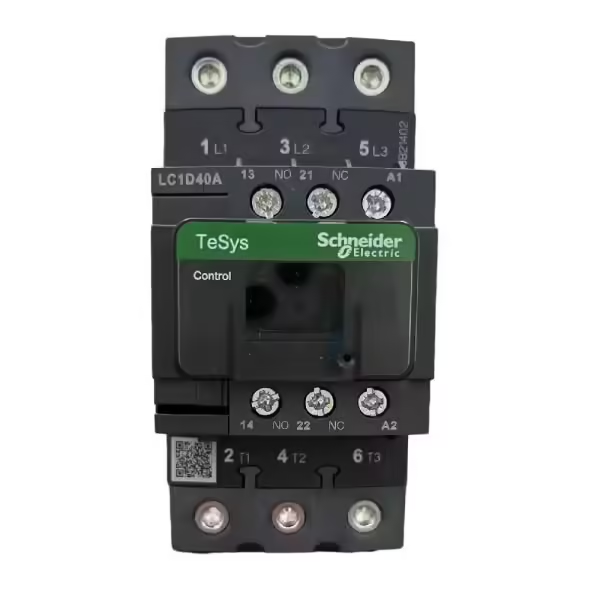LC1D40AM7 Schneider is a TeSys Deca contactor, 3 poles (3NO), up to 40A/440V AC-3/3e (18.5kW@400V) for motor control applications.
It has a built-in 1NO+1NC auxiliary contact (NC mirror approved), a 220V 50/60Hz AC coil, power connection via EverLink BTR screw connectors, and control connection via screw clamp terminals.
The operation of a Schneider contactor LC1D40AM7 :
Typically, a single pole contactor is used as an electromagnetic switching device that has the ability to automatically turn on or off power to a circuit. Contactors can automatically turn on or off electrical connections without the need for operator intervention because they operate on the basis of electromagnetic principles.
Electrical devices called contactors are frequently used to turn circuits on and off. As a result, electrical contactors belong to the relay subclass of electromagnetic switches. An electromagnetic coil is used by a relay, an electrically powered switching device, to open and close a set of contacts.
Why do we use contactor instead of relay?
Relays are appropriate for low to medium-current loads, whereas contactors are made to handle high-current loads. The design and construction of the devices, with contactors having larger, stronger auxiliary contacts to handle higher currents, are the cause of this variation in load capacity.
Applications for a contactor include heating, other electrical loads, lighting, thermal evaporators, and electric motors. Contactor capacity and size vary. There are large ones that are about a meter on the side, and there are little ones that you can pick up with ease.
LC1D40AM7 Schneider Contactor’s Benefits
Apart from their widespread use as a preventive measure, magnetic contactors offer numerous additional advantages. Let’s examine a few more advantages that come with using a magnetic contactor.
The capacity to remotely regulate circuits is one of a magnetic contactor’s most significant advantages. Particularly helpful in the commercial and industrial sectors, where machinery and equipment must be operated from an automated system or central control panel, this function enhances ease and operational efficiency.
Modern magnetic contactors have an energy-efficient design that reduces power usage. Businesses can lower their energy costs and meet their sustainability objectives by minimizing their environmental effect.
Magnetic contactors in electrical systems provide a higher level of safety. High-voltage circuits that are remotely operated require less direct human interaction with potentially dangerous electrical components.
Due to their versatility, magnetic contactors can be used in anything from simple home lighting control to complex industrial motor management systems. They are a vital component of many automation and electrical systems because of their extreme adaptability.
These devices are built to last and function reliably under harsh conditions. Magnetic contactors are favored over conventional switches for long-term reliability in commercial and industrial applications because of their easy resistance to mechanical damage.
Because they have fewer moving parts and a more robust design than conventional mechanical switches, magnetic contactors require less maintenance. The overall savings are increased by lower maintenance costs and downtime.
Related products part number:
LC1D65P7 , LC1D95 , LC1D18 , LC1D09F7, LR97D07M7, LAD7B106 , LC1D65AU7 , LRD3361 , A9F44320 , XB4BS8445 , A9F44220
Previous: xpsaf5130p Schneider Safety Relay





